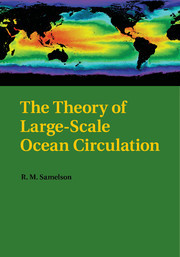Description
The Theory of Large-Scale Ocean Circulation
Author: Samelson R. M.
This is a concise but comprehensive introduction to the basic elements of the theory of large-scale ocean circulation for advanced students and researchers.
Language: English
Subject for The Theory of Large-Scale Ocean Circulation:
Approximative price 44.52 €
In Print (Delivery period: 14 days).
Add to cart
The Theory of Large-Scale Ocean Circulation
Publication date: 03-2018
Support: Print on demand
Publication date: 03-2018
Support: Print on demand
Approximative price 116.48 €
In Print (Delivery period: 14 days).
Add to cart
The theory of large-scale ocean circulation
Publication date: 06-2011
208 p. · 18.3x25.9 cm · Hardback
Publication date: 06-2011
208 p. · 18.3x25.9 cm · Hardback
Description
/li>Contents
/li>Biography
/li>
Mounting evidence that human activities are substantially modifying the Earth's climate brings a new imperative to the study of the ocean's large-scale circulation. This textbook provides a concise but comprehensive introduction to the theory of large-scale ocean circulation, as it is currently understood and established. Students and instructors will benefit from the carefully chosen chapter-by-chapter exercises. This advanced textbook is invaluable for graduate students and researchers in the fields of oceanic, atmospheric and climate sciences, and other geophysical scientists, as well as physicists and mathematicians with a quantitative interest in the planetary fluid environment.
1. Basic physical principles and equations; 2. Reduced equations for large-scale motion; 3. Planetary geostrophic vorticity dynamics; 4. Stratified large-scale flow; 5. Circulation in a rectangular mid-latitude basin; 6. Eddy-driven subsurface motion; 7. Circumpolar flow; 8. Mid-depth meridional overturning; 9. Thermohaline effects; 10. Theory and observation.
R. M. Samelson is a Professor of Oceanic and Atmospheric Sciences at Oregon State University. He received a B.S. in Physics from Stanford University, California and an M.S. in Mathematics and Ph.D. in Physical Oceanography from Oregon State University. He was the recipient of an Office of Naval Research Young Investigator Award and has served as editor of the Journal of Physical Oceanography and on numerous scientific program and review committees. He has authored or co-authored more than seventy-five peer-reviewed scientific publications on topics in physical oceanography, atmospheric science and geophysical fluid dynamics, as well as a book on Lagrangian motion in geophysical flows and several book chapters on various aspects of physical oceanography and geophysical fluid dynamics. This book is based on lecture notes that he has developed over the past decade for a graduate course in large-scale ocean circulation theory at Oregon State University.
© 2024 LAVOISIER S.A.S.




